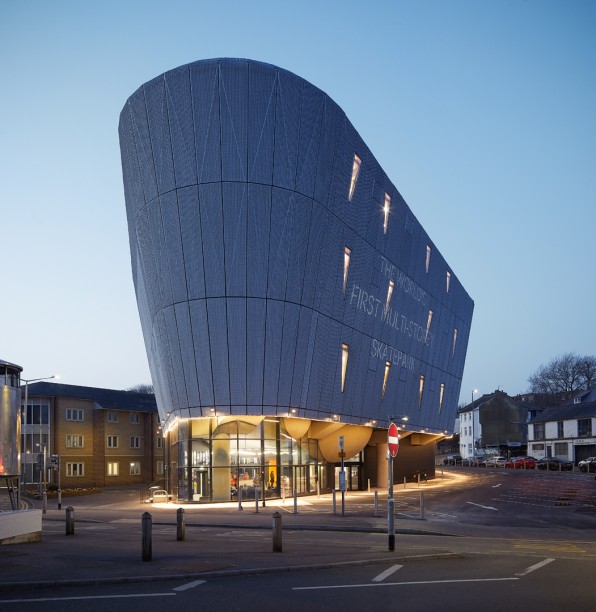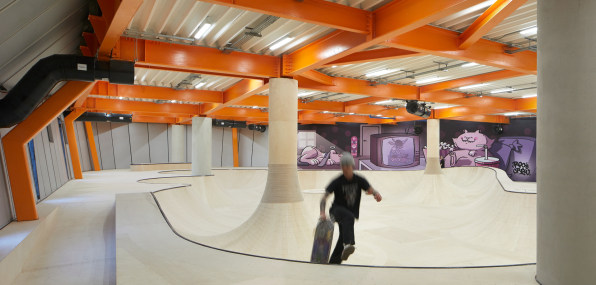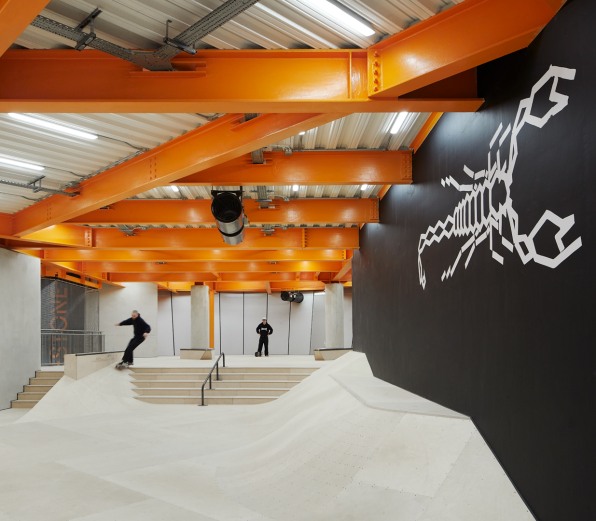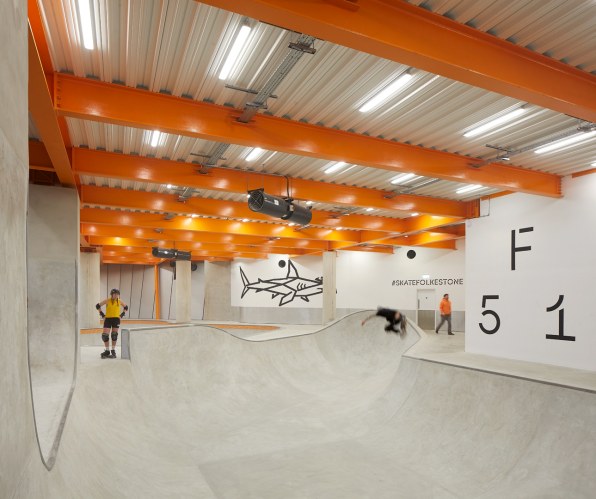- | 11:45 am
See inside the world’s first three-story skate park

The UFO-like building was supposed to be a multistory car park. Then the city lost a beloved skate park nearby, and the architects were asked to design a new one on top of the car park. Then the cars were deemed “boring,” and the multistory car park became a multi-story skate park.

[Photo: ©Hufton+Crow/courtesy Hollaway Architects]
Located in Folkestone, a seaside town in Kent, on the English Channel, the new skate park may well be the most functional architectural folly ever built. Rising from the ground like a near-windowless spaceship shrouded in metal mesh, the so-called F51 contains not one, not two, but three skate parks stacked one on top of each other like the most engineered layer cake ever made. There’s also a climbing wall stretching along the full height of the building and a boxing ring on the ground floor.The sports center is a 17 million-pound gift (that’s a little more than $22 million) by Sir Roger de Haan, a local businessman who sold his Saga Group empire for 1.3 billion pounds (or about $1.75 billion) in 2004 and has since infused millions into the town’s regeneration. Starting April 4, when the building opens to the public, F51 will become another step in the town’s transformation, which has already enhanced its harbor with a promenade and is in the process of lining the seafront with 1,000 homes, shops, and restaurants.

[Photo: ©Hufton+Crow/courtesy Hollaway Architects]
A STACK OF SKATE PARKS
F51 boasts over 20,000 square feet of ramps and bowls and dips and ledges, spread across three levels. “That’s the biggest skate-able space we’ve ever created,” says Russ Holbert, a director at Maverick Skateparks, which has built 155 skate parks over the last 14 years in the U.K.

[Photo: ©Hufton+Crow/courtesy Hollaway Architects]
The first floor is home to a striking bowl park made of concrete. The star is a 9-foot-deep bowl, which, in an act that appears to defy gravity, hangs completely freestanding and unsupported. You can, in fact, walk right underneath the bulging bowl as you enter the building one floor down. Guy Hollaway, whose firm Hollaway Architects, designed the building, says you can even hear the skaters rattling above your head while you’re standing in the lobby café.

[Photo: ©Hufton+Crow/courtesy Hollaway Architects]
The second floor was designed to function like a street park, complete with urban obstacles like stairs, railings, and benches. The space is interrupted by a few columns, which were integrated into the design with ramps that curve up like reverse funnels. The third floor is set up like a flow park, with few obstacles and shallow dips. “Rather than having pools or bowls, the whole space is connected so users can flow seamlessly in an infinite, ever-changing line,” says Ian Jennings, head designer at Maverick.

[Photo: ©Hufton+Crow/courtesy Hollaway Architects]
The skate park trifecta provides three different kinds of experiences, but it also makes the sport accessible to more people, regardless of their skill level. For example, both the second- and third-floor skate parks were made of timber by another British company called Cambian. Unlike concrete, timber is much softer to fall on, and is therefore seen as a more user-friendly option for beginners. Aside from being more sustainable than concrete, a timber skate park also means that the platform can be taken apart and updated.

[Photo: ©Hufton+Crow/courtesy Hollaway Architects]
A TOOL FOR REGENERATION
Someone unacquainted with skating might question the need for three entire skate parks when two floors could have been used for, well, anything else. But the sports center is banking on the skate parks becoming a central hub for youth culture. “This is about investing in young people,” says Hollaway. “If we can make their memory of their childhood a positive one through skating and climbing, they might stay in the town, and if they stay, they’ll invest.”

[Photo: ©Hufton+Crow/courtesy Hollaway Architects]
The sports center is located on the edge of one of the most deprived neighborhoods in Kent. And yes, it started as a car park, but by stacking three skate parks, the architects were able to triple the skating area on a plot of land that’s hamstrung by narrow streets.F51 will offer 1 pound memberships (about $1.32) to young people under age 16 who are enrolled in a local school. Hollaway says there are also plans to build skateboarding into the curriculum. This idea that play, and skateboarding in particular, can benefit young people’s mental health is not without precedent. In the town of Dorchester, for example, crime and anti-social behavior dropped by 19% since the Dorchester Skatepark opened in 2009, and by 33% in the area around the skate park itself (which was also designed by Maverick). “A lot of young people don’t have spaces they can call their own,” says Sam Reynolds, a director at Maverick. “To have these spaces, which have been entrusted to them to feel ownership over, really nurtures and creates this environment that is so positive.”
Of course, nothing will ever beat an open-air skate park, with free admission and no opening hours. But three skate parks for the price of one may well be the next best thing.




































